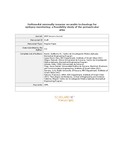Mostrar el registro sencillo del ítem
Multimodal minimally invasive wearable technology for epilepsy monitoring: a feasibility study of the periauricular area
| dc.creator | Besné, Guillermo M. | es_ES |
| dc.creator | López Iturri, Peio | es_ES |
| dc.creator | Alegre, Manuel | es_ES |
| dc.creator | Artieda, Julio | es_ES |
| dc.creator | Trigo Vilaseca, Jesús Daniel | es_ES |
| dc.creator | Serrano Arriezu, Luis Javier | es_ES |
| dc.creator | Falcone Lanas, Francisco | es_ES |
| dc.creator | Valencia Ustárroz, Miguel | es_ES |
| dc.date.accessioned | 2024-01-09T12:54:16Z | |
| dc.date.available | 2024-01-09T12:54:16Z | |
| dc.date.issued | 2023 | |
| dc.identifier.citation | Besné, G. M., Lopez-Iturri, P., Esteban, M. A., Granda, J. A. G., Trigo, J. D., Serrano-Arriezu, L., Falcone, F., & Ustarroz, M. V. (2023). Multimodal minimally invasive wearable technology for epilepsy monitoring: A feasibility study of the periauricular area. IEEE Sensors Journal, 23(21), 26620-26635. https://doi.org/10.1109/JSEN.2023.3314190 | en |
| dc.identifier.issn | 1530-437X | |
| dc.identifier.uri | https://hdl.handle.net/2454/46989 | |
| dc.description.abstract | Ambulatory monitoring is of great interest in both clinical and domestic environments. Despite the technological advances, few monitoring solutions are suitable for medical application and diagnosis. Here, we investigate the feasibility of targeting the periauricular area (ear pavilion, ear canal, and the surrounding skin areas) to implement a multimodal system that fulfills the requirements of ergonomics and minimal obstructiveness in the context of epilepsy monitoring. Six physiological signals are selected and explored for their integration in the area of interest and a ¿proof-of-concept¿ prototype integrating the components in a single portable device targeting the selected location is implemented. Results show mixed results where some parameters are highly reliable, and others are impractical or require customized technology to provide clinically relevant information. To enable data acquisition, storage, and processing within the Internet of Medical Things paradigms, wireless body area transceiver integration is also analyzed in terms of coverage/capacity relations, showing feasibility for such device configuration. | en |
| dc.description.sponsorship | This work was supported in part by the Department of Economic Development of the Government of Navarra under Grant GN 2019 PC078-079; in part by the Carlos III Health Institute through the project under Grant DTS19/00130 (co-financed by the European Regional Development Fund; “A way to make Europe”); and in part by the Agencia Estatal de Investigación, Fondo Europeo de Desarrollo Regional -FEDER-, European Union under Grant PID2021-127409OB-C31 CONDOR. | en |
| dc.format.mimetype | application/pdf | en |
| dc.language.iso | eng | en |
| dc.publisher | IEEE | en |
| dc.relation.ispartof | IEEE Sensors Journal 23(21), 26620-26635 | en |
| dc.rights | © 2023 IEEE. Personal use of this material is permitted. Permission from IEEE must be obtained for all other uses, in any current or future media, including reprinting/republishing this material for advertising or promotional purposes, creating new collective works, for resale or redistribution to servers or lists, or reuse of any copyrighted component of this work in other work. | en |
| dc.subject | Ambulatory monitoring | en |
| dc.subject | Epilepsy | en |
| dc.subject | Multimodal wearable | en |
| dc.subject | Periauricular area | en |
| dc.title | Multimodal minimally invasive wearable technology for epilepsy monitoring: a feasibility study of the periauricular area | en |
| dc.type | Artículo / Artikulua | es |
| dc.type | info:eu-repo/semantics/article | en |
| dc.date.updated | 2024-01-09T12:43:46Z | |
| dc.contributor.department | Institute of Smart Cities - ISC | en |
| dc.rights.accessRights | Acceso abierto / Sarbide irekia | es |
| dc.rights.accessRights | info:eu-repo/semantics/openAccess | en |
| dc.identifier.doi | 10.1109/JSEN.2023.3314190 | |
| dc.relation.projectID | info:eu-repo/grantAgreement/ISCIII/Plan Estatal de Investigación Científica y Técnica y de Innovación 2017-2020 (ISCIII)/DTS19%2F00130/ES/ | en |
| dc.relation.projectID | info:eu-repo/grantAgreement//PID2021-127409OB-C31 | en |
| dc.relation.projectID | info:eu-repo/grantAgreement/Gobierno de Navarra//GN 2019 PC078-079 | en |
| dc.relation.publisherversion | https://doi.org/10.1109/JSEN.2023.3314190 | |
| dc.type.version | Versión aceptada / Onetsi den bertsioa | es |
| dc.type.version | info:eu-repo/semantics/acceptedVersion | en |


